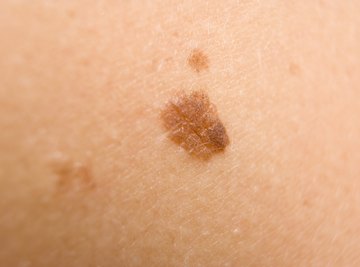
Mitosis is the process by which the overwhelming number of cell divisions in eukaryotic organisms occur. Eukaryotes (animals, plants and fungi) typically consist of literally trillions of cells, and at any time, countless worn-out, dead or irreparably damaged body cells need to be replaces. Mitosis is the eukaryotic answer to binary fission in the single-celled prokaryotes, which is similar on the surface but simpler at the level of details.
Mitosis in humans is fundamentally the same as it is in all eukaryotes. Differences in how mitosis and cytokinesis are carried out, however, do occur as a result of structural and anatomical differences between eukaryotic species.
TL;DR (Too Long; Didn't Read)
The take-home message is that both mitosis and meiosis are unique to eukaryotes; binary fission is unique to prokaryotes but has several features in common with mitosis.
An Overview of Cells
Prokaryotic life forms and cells have existed for some 3.5 billion years, and in that time are believed to have retained essentially all of their few important and distinguishing features. All cells have a cell membrane, genetic material in the form of DNA (deoxyribonucleic acid), a gel-like cytoplasm filling the interior, and ribosomes that make proteins. Prokaryotic cells, however, have essentially only these features, along with enzymes and other small molecules that participate in metabolic reactions.
Eukaryotic cells include these things and more, including a number of membrane-bound structures on the interior called organelles. The DNA of eukaryotic cells is enclosed in a nucleus, which is delimited by a double plasma membrane similar to the cell membrane. This DNA is divided into a number of individual chromosomes (humans have 46, 22 numbered autosomes and one sex chromosome from each parent).
Cell Division: Terminology
Mitosis is the division of a eukaryotic nucleus containing a set of replicated chromosomes. That is, before this division occurs, all 46 chromosomes have been copied, with one copy of each destined for a daughter nucleus following mitosis and cytokinesis.
Cytokinesis is the division of the entire cell and follows mitosis. In fact, cytokinesis actually begins during the third of the four phases of mitosis, with the two processes coordinated such that cytokinesis can get rolling at the earliest possible moment.
Binary fission is the replication of a prokaryotic cell and hence, in most cases, the whole organism.
Meiosis is a series of two successive cell divisions that produce cells with 23 individual chromosomes instead of 46 homologous chromosomes, the term for the same-numbered chromosomes from both parents. (Your chromosome 9 from your mother and your chromosome 9 from your father are homologous chromosomes.)
- In what type of cells does mitosis occur? In eukaryotes, the only cells that undergo non-mitotic divisions are special gamete-producing cells in the gonads (ovaries in women and testes in men).
Mitosis vs. Binary Fission
In binary fission, the single, small, usually circular prokaryotic chromosome including all of the organism's DNA is attached to the cell membrane and replicates itself, growing toward the opposite end of the cell. As it does so, it creates a second "ring" attached to the original. The entire construct then splits more or less down the middle, resulting in genetically identical daughter cells.
The Steps of Mitosis
Mitosis is classically divided into four phases; many newer sources include five.
- In prophase, the chromosomes condense and the mitotic spindle (tiny tubes consisting of proteins) forms at each pole of the cell.
- In prometaphase, the duplicated chromosome sets (called sister chromatids) migrate toward the midline of the cell.
- In metaphase, the chromosomes line up at the midline at the metaphase plate, with one sister chromatid in each pair on either side of this plate.
- In anaphase, the chromatids are pulled apart toward opposite poles by the mitotic spindle tubes. Cytokinesis begins as the cell membrane starts to pinch inward from a direction at either "end" of the metaphase plate.
- In telophase, new membranes form around the two new daughter nuclei.
Mitosis vs. Meiosis
Meiosis includes two rounds of the five steps of mitosis, but with many twists to ensure that the sperm or egg cell created is genetically different from either parent. This is caused by crossing over (the exchange of bits of DNA between homologous chromosomes) and independent assortment (the random way in which a given gamete gets either the mother's homologous chromosome or the father's for any chromosome, meaning that 223 = 8.4 million unique gametes can arise thanks to this event alone).
References
About the Author
Kevin Beck holds a bachelor's degree in physics with minors in math and chemistry from the University of Vermont. Formerly with ScienceBlogs.com and the editor of "Run Strong," he has written for Runner's World, Men's Fitness, Competitor, and a variety of other publications. More about Kevin and links to his professional work can be found at www.kemibe.com.
Photo Credits
BananaStock/BananaStock/Getty Images
